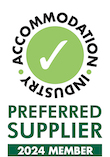5 Biggest Disease Hotspots in Your Caravan Park’s Gym
Other than getting your guests in shape, your gym could potentially get them sick too!
Shocking right?
Well, research shows that gyms can be hotbeds for germ activity thanks to the germs gym goers leave behind. The sweaty, damp, and high touch nature of gyms make them the ideal Petri dish for microbes and pathogens.
“The biggest thing about the gym is there are a lot of areas where germs, viruses, and fungus can be year-round. Even if the handlebars are cleaned regularly, they are still going to be covered in bacteria. You need to use wipes or a disinfectant spray to wipe down the machines and weights before and after every use.”
Bryan Combs, Nurse Practitioner, University of Alabama, Birmingham School of Nursing.
In a study published in the Clinical Journal of Sports Medicine, we learn that 63% of gym equipment harbours rhinoviruses. These are responsible for upper respiratory tract infections like the common cold.
And other than viruses, countless bacteria and fungi also lurk in different areas of the gym. Potentially putting your guests at risk of dangerous infections.
What’s more, these germs can survive on different surfaces for anywhere from a few minutes to several days. This depends on the surface and the type and number of pathogens.
Here are the five biggest disease hotspots in your gym and how to properly clean them.
Hotspot # 1: The Shower and Locker Room
 Image Courtesy
Image Courtesy
High humidity in locker rooms creates ideal conditions for germs to thrive. Some of the biggest threats include bacteria like Staphylococcus, Streptococcus, and MRSA.
People track in a wide range of germs from outside into the locker room on their shoes. Some of these microorganisms cause illnesses ranging from the flu to hepatitis.
Gym showers are no better either. They offer ideal conditions for the growth of fungi. Tinea fungi, for instance, causes infections like athlete’s foot, ringworms, and warts.
To help curb the spread of harmful germs in the showers and locker room, you need to:
- Ensure proper cleaning and disinfection of the locker room and showers. You can do this only by using the right cleaning equipment and products.
- Provide the cleaning staff with the necessary personal protective equipment. PPE protects them from dangerous microbes and harsh cleaning products.
- Use a cleaning schedule and checklist to ensure regular cleaning.
- Ensure a well-stocked locker room and shower. This involves ensuring all the following are always well-provisioned:
- Soap dispensers
- Hand sanitiser dispensers
- Paper towel dispensers
- Toilet paper dispensers


- Enforce a no bare feet policy within the gym. Walking barefoot is one of the main ways to pick up an infection at the gym.
- Use educational posters to educate the guests on best practices to curb the spread of germs.
Hotspot # 2: Spin Bikes
 Image Courtesy
Image Courtesy
Spin bikes are a hotspot for potentially dangerous bacteria and viruses.
“The handlebars and seats, particularly if they’re made from soft and squishy material, can contain germs ranging from Staphylococcus to E. coli and other things that can cause stomach upsets.”
Dr Michael Schmidt, PhD, Professor at the Medical University of South Carolina.
Spin bikes can also harbour and aid the spread of viruses like Influenza and COVID-19. These viruses spread when people touch contaminated surfaces and then touch their faces.
To prevent the spread of diseases through your gym spin bikes, you should:
- Provide cleaning stations to encourage guests to clean the equipment before and after use.
- Ensure the staff disinfects high touch surfaces like the handlebars and seats regularly throughout the day.
- Use educational posters to remind guests and staff to observe proper hygiene.
Hotspot # 3: Treadmills
 Image Courtesy
Image Courtesy
Although treadmills are more likely to get cleaned after use, they still harbour a significant amount of germs.
According to a study in the Clinical Journal of Sports Medicine, 63% of disinfected equipment still has traces of germs.
Among these are viruses like the Rhinovirus, Coronavirus, Staphylococcus bacteria, fungi, and yeast.
As with the spinning bikes, there are measures you can take to curb the growth of germs on your treadmills. These include:
- Regular cleaning and disinfection by the staff throughout the day.
- Cleaning stations to encourage members to disinfect the machines before and after use.
- Enforce random spot checks to ensure all equipment is clean and disinfected accordingly.
Hotspot # 4: Yoga Mats
 Image Courtesy
Image Courtesy
Yoga mats are notorious for harbouring a wide range of germs and bacteria. They’re often neglected when cleaning, making them ideal homes for harmful germs.
Additionally, the constant contact with sweaty skin facilitates easy germ transference. Dirty yoga mats host germs that can cause skin infections and even Staph.
To effectively clean your yoga mats, you need to:
- Scrub and hose down the mats daily to avoid any build-up of germs.
- Have enough mats in stock for two or three classes so you can rotate and disinfect them between sessions.
- Install mat hangers. Airing out the mats prevents moisture retention and discourages microbial growth.
- Provide disinfecting sprays. This will encourage gym members to disinfect the yoga mats before and after use.
Hotspot # 5: Towels
 Image Courtesy
Image Courtesy
Even after a wash, gym towels can still pick up germs from the laundry basket, benches, or lockers.
For instance, it's common knowledge that most gyms use the same hamper to carry dirty and clean towels. This is a practice that enables cross-contamination between clean and dirty towels.
Additionally, some people use the same gym towels on their bodies, and to wipe down equipment.
“Everything is being wiped indiscriminately. And, as a result, germs from all surfaces end up on that towel. Unless you’ve soaked the towel in hot water or disinfectant, for three minutes, you’ll spread bacteria to other surfaces, including your skin.”
Jason Tetro, Microbiologist, Author of The Germ Files.
According to a study published in The Journal of Infection in Developing Countries, MRSA can survive for up to a few days on towels.
This presents a potential health hazard to your gym members. MRSA is an antibiotic-resistant strain of Staphylococcus aureus that is difficult to treat.
Gym towels can also harbour other pathogens such as E. coli, Streptococcus, and Herpes.
Thankfully, there are steps you can take to combat these pathogens. These are:
- Ensure you launder the towels using the warmest water setting and finish them off in a hot drier.
- Some bacteria and viruses can survive in “clean” towels when inadequately laundered.
- Educate your staff on the proper handling and storage of towels. Poor handling, like the use of one hamper for clean and dirty towels, leads to contamination.
- Implement a towel tracking and inventory system. This will make it easier to track towels within your gym, for cleaning and to prevent loss.
Proper hygiene at the gym is critical. It creates an inviting atmosphere and nurtures brand-positive impressions with your clients.
According to an IHRSA report, hygiene is essential to member satisfaction and retention. Furthermore, up to 90% of members are more likely to renew their membership based on the standards of cleanliness.
Proper hygiene also helps mitigate the spread of harmful infections. This is even more important right now, given the current COVID-19 pandemic.
A clean space also helps put your clients at ease. It indicates that you care about their wellbeing. And shows you are taking the necessary precautions to safeguard their health. Further fostering sentiments of goodwill, which is great for business.
Source: Andrea Piacquadio

















